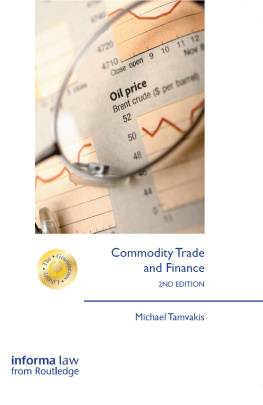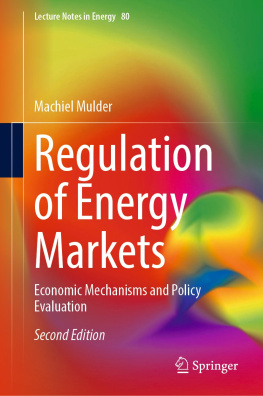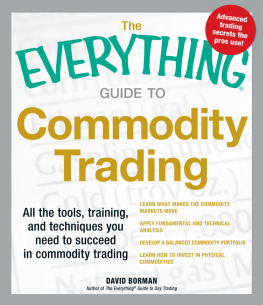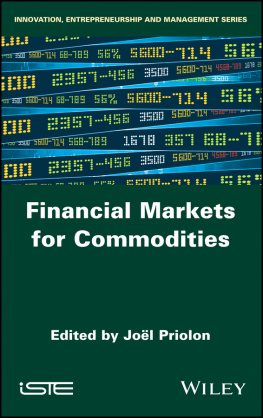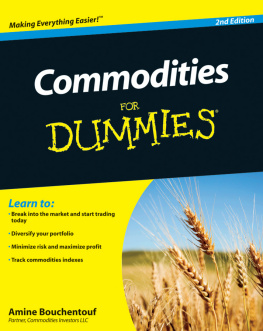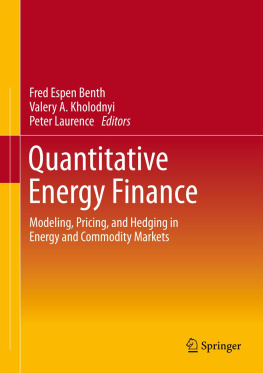
Commodity Trade and Finance
What affects the supply of oil? How important is the weather in determining grain prices? Why has the price of copper skyrocketed?
This unique book analyses the economics of key commodity groups, including energy, agriculture and metals. It examines the supply/demand fundamentals of several major and minor commodities, physical characteristics, production and consumption patterns, trade flows and pricing mechanisms. It also explains the main tools used to hedge price risk, such as futures, options and swaps.
This second edition has been fully revised and restructured, and contains four new chapters, including oil refining, electricity and price risk management for energy, metals and agricultural commodities.
This book is an indispensable reference text for students, academics and those working in the commodity business.
Michael Tamvakis is Professor of Commodity Economics and Finance at Cass Business School, where he lectures in international commodity trade, commodity derivatives and trading, energy economics and shipping economics.
The Grammenos Library
Commodity Trade and Finance, Second Edition
Michael Tamvakis
(2014)
Port Infrastructure Finance
Hilde Meersman, Eddy Van de Voorde and Thierry Vanelslander
(2014)
Modelling and Shipping in Dry Bulk Forecasting
Shun Chen, Hilde Meersman, Eddy Van de Voorde and Koos Frouws
(2014)
The Handbook of Maritime Economics and Business, Second Edition
Costas Th. Grammenos
(2010)
Future Challenges for the Port and Shipping Sector
Hilde Meersman, Eddy Van de Voorde and Thierry Vanelslander
(2009)
Maritime Safety, Security and Piracy
Wayne Talley
(2008)
Commodity Trade and Finance
Michael Tamvakis
(2007)
The Handbook of Maritime Economics and Business, Second Edition
Costas Th. Grammenos
(2002)
Commodity Trade and Finance
Second Edition
Michael Tamvakis

Second Edition published 2015
by Informa Law
2 Park Square, Milton Park, Abingdon, Oxon OX14 4RN
and by Informa Law from Routledge
711 Third Avenue, New York, NY 10017
Informa Law is an imprint of the Taylor & Francis Group, an informa business
2015 Michael Tamvakis
The right of Michael Tamvakis to be identified as the author of this work has been asserted in accordance with sections 77 and 78 of the Copyright, Designs and Patents Act 1988.
All rights reserved. No part of this book may be reprinted or reproduced or utilised in any form or by any electronic, mechanical, or other means, now known or hereafter invented, including photocopying and recording, or in any information storage or retrieval system, without permission in writing from the publishers.
First Edition published by Informa 2007
Trademark notice: Product or corporate names may be trademarks or registered trademarks, and are used only for identification and explanation without intent to infringe.
British Library Cataloguing in Publication Data
A catalogue record for this book is available from the British Library
Library of Congress Cataloging in Publication Data
Tamvakis, Michael N.
Commodity trade and finance/by Michael Tamvakis. Second edition.
pages cm. (The Grammenos library)
Summary: This second edition has been fully revised and restructured, and contains four new chapters, including oil refining, electricity and price risk management for energy, metals and agricultural commodities Provided by publisher.
Includes bibliographical references and index.
ISBN 978-0-415-73245-1 (hardback) ISBN 978-1-315-76741-3
(ebook) 1. Primary commodities. 2. Primary commodities Prices. 3. International trade. 4. Commodity exchanges. I. Title.
HF1040.7T36 2015
332.6328 dc23
2014033291
ISBN: 978-0-415-73245-1 (hbk)
ISBN: 978-1-315-76741-3 (ebk)
Typeset in Plantin
by Florence Production Ltd, Stoodleigh, Devon, UK
To Rebecca, Nicholas and Artemis
Contents
Chapter 1 |
Chapter 2 |
Chapter 3 |
Chapter 4 |
Chapter 5 |
Chapter 6 |
Chapter 7 |
Chapter 8 |
Chapter 9 |
Chapter 10 |
Chapter 11 |
Chapter 12 |
Chapter 13 |
Chapter 14 |
Chapter 15 |
Chapter 16 |
Although all main groups of commodities are of paramount importance to our everyday lives, energy is the one that manages to capture our immediate attention, particularly in times of crises. Both by value and volume, energy constitutes the largest of the key commodity groups (the other two being metals and agriculture).
We start by looking at the fundamental economics of energy, before focusing on the key commodities making up this group. We elaborate on the economics of demand for, and supply of, exhaustible energy resources. The role and cross-substitutability of alternative energy resources will also be discussed, and subsequent chapters will elaborate on the three main commodities in this group: crude oil and refined products, natural gas, and coal. Finally, we will also take a brief look at the electricity industry. Although less thought of as a commodity, electricity is important, not only because it absorbs substantial amounts of primary energy commodities for its generation, but also because, in the last few decades, it has become a tradable commodity itself.
First of all, it is worth taking a moment to consider two seemingly simple questions: What is energy? and How do we measure it? To answer the first question, the OED helps us by providing a formal definition:
energy / ndi / noun
[French nergie or late Latin energia from Greek energeia (), formed as EN- () ergon () work]
6 SCIENCE The ability to do work, i.e. move a body. Orig., that possessed by a body by virtue of its motion b This ability provided in a readily utilized form, such as electric current or piped gas; resources that can be drawn on for this purpose.
This definition immediately highlights that energy can appear in different forms. Boyle (2004, pp. 46) gives a brief but comprehensive review of energy forms and summarises four basic ones: kinetic, gravitational, electrical and nuclear. Obvious examples of kinetic energy would be the wind spinning a turbine, human and animal power, or a wound spring. Gravitational is the energy stored in an object that is lifted against the gravitational pull of the earth. Water stored in a dam is an example of stored (or potential) gravitational energy, and when the water is released it can transfer its energy to spinning a generator that produces electricity. Electrical energy, at its most fundamental level, is what keeps charged subatomic particles together into atoms and atoms into molecules. At this level, chemical energy can also be considered as electrical energy, which is then turned into heat (via kinetic energy) once a chemical reaction is in progress. Electrical energy is, of course, associated with electric currents, or the much more familiar electricity, which is an intermediary energy form that is generated using a number of different methods (burning a fuel, spinning a wind turbine, using a photovoltaic cell and so on), travels from a generator to a consumption point and is eventually transformed into another form of energy (light, heat, kinetic energy) that is required by the final consumer. Finally,
Next page
